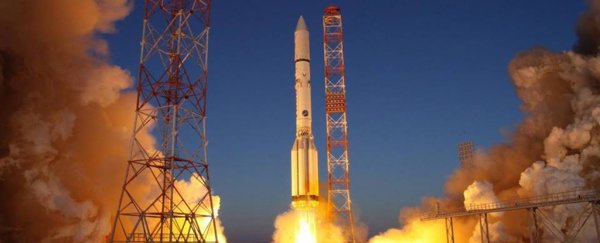One of the reasons space exploration is so exciting is that there are so many possibilities – like powering a rocket to Mars in record time using nuclear reactions. That's the rather outlandish plan being put together by Russian scientists, and it's one of the first to propose a solution to getting home from the Red Planet once we get there.
Existing schemes, including the ones scheduled by NASA for the 2030s, don't factor in the fuel or resources for a return trip, which means the first human settlers would have to live out the rest of their days there. Previous proposals have also reckoned with a journey time of something like 18 months, which means astronauts are more at risk of contracting various diseases and ailments along the way.
It's actually Russia's national nuclear corporation, Rosatom, that has the big idea for a nuclear-powered spaceship, and it's not a completely new concept either: both Russia and the United States were working on similar systems during the Cold War of the 1960s and onwards, although their efforts were focused on lightweight orbital satellites rather than space vehicles to take us to Mars and back again.
One of the biggest drawbacks is going to be the cost. "A nuclear contraption should not be too far off, not too complicated," Nikolai Sokov, senior fellow at the James Martin Centre for Nonproliferation Studies in California, told Wired. "The really expensive thing will be designing a ship around these things."
While Rosatom's representatives haven't gone into detail about how the company's technology will work, it's likely to be some form of thermal fission, where the heat of splitting atoms are used to burn hydrogen or another chemical, providing propulsion for the spaceship. It's similar in principle to chemical propulsion, where one chemical (the oxidiser) burns another (the propellant) to power a vehicle along.
The key difference with chemical propulsion is you need more and more fuel, which makes your vehicle heavier and heavier, a problem that thermal fission would solve. If the Russian team is successful in its aims (and that's a big, huge "if"), the research could help improve orbiting satellite technology and perhaps contribute to the creation of a space junk collector on the edges of Earth's atmosphere.
"A vehicle equipped with a nuclear engine is expected to have 30 times the power reserve of conventional spaceships," explains Rosatom. "The designs we are developing will enable mankind to build spaceships that can address all the space challenges of the 21st century, such as cargo transport, removal of space debris, asteroid impact avoidance, etc."
A prototype will be ready for flight testing in 2018, according to the company, if they can get the funds together. Nick Stockton from Wired reports that Rosatom has only budgeted 15 billon rubles for the project (about US$700 million), which he calls "eyebrow-raisingly cheap for a 15-year long space project". For comparison, he adds, NASA's Space Launch System is projected to cost nearly $10 billion.
We'll just have to wait and see what those Russian rocket scientists have up their sleeves in the next few years.
